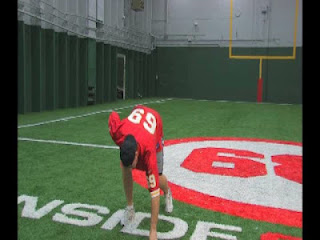 |
During last off-season I spent a lot of time studying
different punt schemes. One which continued to catch my eye was the “Shield
Punt”. A ton of college programs were
using it and I had previously read an article about it in one of the American
Football Coaches Association publications. I also solicited input from the
Coach Huey community and thought I had been convinced to move forward with my
plans.
Still, I found myself doubting its effectiveness. We had
been punting from a spread formation and were a half man, half zone protection
unit. That punt scheme was something I felt extremely comfortable with and knew
inside-out. But, we continued to have issues getting downfield and covering
kicks and teaching the protection scheme was not economical. Our number one
issue was that we had trouble getting downfield and covering kicks. We are not
the type of team that is going to be successful in space against some of the
athletic teams we face in our league.
Knowing this, I decided to make the leap and change our
scheme last summer. I planned out the necessary details and drills and moved
ahead with a plan to install our version of the Shield Punt.
Boy, were we happy we did!
 |
| Our big boys loved being the heart of the punt team! |
We attempted 31 punts this season. Our punter averaged 31.4
yards per attempt and we downed six kicks inside the 20-yard line including one
that died on the one-yard line. Out of those 31 punts, opponents didn’t even
attempt to field the kick 20 times!
Think about that! Two-thirds of our punts were not even
returnable. We didn’t have to attempt to make a tackle on 67% of our punts!
This is because the Shield Punt releases defenders into
lanes right away and high school returners (and some coaches for that matter) don’t want
to touch a ball if they’re in a crowd for fear of muffing the kick.
Out of the other 11 punts, six were fair caught (including
five alone in our playoff game). We only had to make a tackle in space five
times throughout the season! That was my main goal with this unit.
Our opponents averaged only two
return yards when we punted (giving us a net of 29.4 yards per punt), with most
coming on a 50-yard return that we missed some easy tackles and probably
out-kicked our coverage on.
Another reason I initially shied
away from the Shield Punt was that I viewed its basic formation as difficult
from which to run a fake from.
I love running fakes on special
teams. I enjoy taking advantage of schematic disadvantages most special teams
units put themselves in and love the momentum-grabbing effect that a converted
fourth-down on special teams can have on an offense.
Our spread punt left the door open
to run whatever type of fake we wanted to. This new Shield Punt seemed like it
wouldn’t fit that mold. It was the last hurdle I had to clear mentally before diving
in head first.
Last season, in our spread punt, we
were 3-for-4 for 78 yards and three converted first downs when we faked a punt.
After some careful studying and a
lot of doodling I found a handful of fakes I thought would work well with the Shield
Punt. They turned out to be a success this year. We were 2-of-3 for 18 yards
and two first downs on fakes. The one we didn’t convert was a bad, emotional
call from me. We didn’t have the numbers advantage we normally look for. I just
felt like we could catch them off guard and get it.
On top of all that we also forced
opponents into four penalties for 50 yards, two of which were roughing the
kicker calls, while only committing one penalty for five yards ourselves.
All in all, we only lost five yards
throughout the entire season on punt when you tally punt return yardage, our
fake yardage and penalty yardage on both sides. That's way better than where we had been in year's past.
Check out some clips below. The last two are fakes we ran successfully this season.
Most weeks we found that teams didn't know how to scheme their punt return or block. Most teams didn't rush or attempt to set up a return. If they did, it wasn't executed well.
One issue we had throughout the season was our front line guys bowing back. Although we never got called for not having enough men on the line of scrimmage, we were warned twice by refs.
We need to get better at blocking at the guard and tackle positions. This season, I didn't coach them up well enough and as such there first steps were off and we lost ground sometimes.
Check out some clips below. The last two are fakes we ran successfully this season.
Most weeks we found that teams didn't know how to scheme their punt return or block. Most teams didn't rush or attempt to set up a return. If they did, it wasn't executed well.
One issue we had throughout the season was our front line guys bowing back. Although we never got called for not having enough men on the line of scrimmage, we were warned twice by refs.
We need to get better at blocking at the guard and tackle positions. This season, I didn't coach them up well enough and as such there first steps were off and we lost ground sometimes.
I will continue to fine tune this
unit in the off-season, but I am now completely sold on the Shield Punt.













